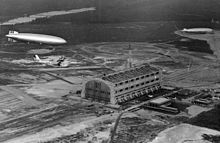Naval Air Engineering Station Lakehurst
The Naval Air Engineering Station Lakehurst is a US Navy base in Lakehurst , New Jersey , around 100 kilometers southwest of New York City .
history
The later airship port area had been the firing range of an ammunition factory since 1915, and from 1918 a test site for poison gas and a training camp for the Army Chemical Warfare Service under the name Camp Kendrick . It was put up for sale by the US Army after the First World War .
On May 16, 1919, the Minister in Charge of the Navy, Franklin D. Roosevelt , decided to purchase 1,700 acres of land in Lakehurst for use as a military base for airships for the Navy. The US Navy began construction work on an airship hangar that could accommodate two rigid airships . Construction began in September 1919. This hall (hangar No. 1) was completed in summer 1921. The other buildings on the airfield were commissioned on June 28, 1921. They were designed for 17 officers and 230 recruits.
The airship, built in Great Britain under the designation R38 (US designation ZR-2 ) for the United States, was to become the first "resident" of the new naval airfield. However, it was destroyed during test drives in England in August 1921.
Therefore, the first airship that Lakehurst used as a home base was the one in Hangar No. 1 ZR-1 "USS Shenandoah" built and in service for the first time in September 1923 . The construction of ZR-1 was to be the cornerstone of an American airship industry. The USS Shenandoah dominated the airship scene in Lakehurst from 1923 to 1925. That year, however, it was destroyed in severe turbulence over Ohio .
The ZR-3 "USS Los Angeles" , the "American airship" built by Zeppelin in Germany as a war reparation for the First World War , brought the US Navy in Lakehurst a lot of experience in dealing with rigid airships from October 1924. The USS Los Angeles made 331 trips with 4181 flight hours before being retired in June 1932. It was the most successful American rigid airship and was used as a ground test object for seven years before it was moved to Hangar No. 1 was dismantled.
Afterwards (from October 1931) Lakehurst became the home airfield for the Akron- built ZRS-4 "USS Akron" , which crashed in April 1933 in bad weather. This event marked the beginning of the decline of American airship travel.
The last large American airship, the ZRS-5 "USS Macon", was based in California . She stayed in Lakehurst for only four months in 1933 to complete the test drives. After her departure on October 12, 1933, an American rigid airship never visited Lakehurst again. After the loss of the USS Macon in February 1935, American airship activities were reduced to a minimum. The naval base only operated a few outdated impact airships .
In 1937, the disaster of the Zeppelin occurred on site LZ 129 "Hindenburg" , that of May 6, 1937 Frankfurt Coming in landing , shortly after dropping the anchor ropes, burst into flames. The exact reasons for the disaster have not yet been fully clarified. 35 of the 97 occupants (13 passengers, 22 crew members) and a man from the ground crew were killed. One of the main reasons for the size of the fire was that the zeppelin was filled with hydrogen instead of the helium that was originally intended . At that time, helium was exclusively produced in large quantities by the USA and, as a raw material essential to the war effort, fell under the embargo imposed on account of the aggressive policies of Nazi Germany at the time . The until then almost accident-free history of the traffic zeppelins ended with the disaster and the confidence of the travelers was shaken. The decline in civilian use of zeppelins could no longer be stopped, primarily due to the political situation.
Even after the Second World War, Lakehurst remained an airship base for American impact airships , including for air surveillance during the Cold War .
Web links
- Navy Lakehurst Historical Society, Inc. (English) ; part of the text is based on Our Airship History on these pages



